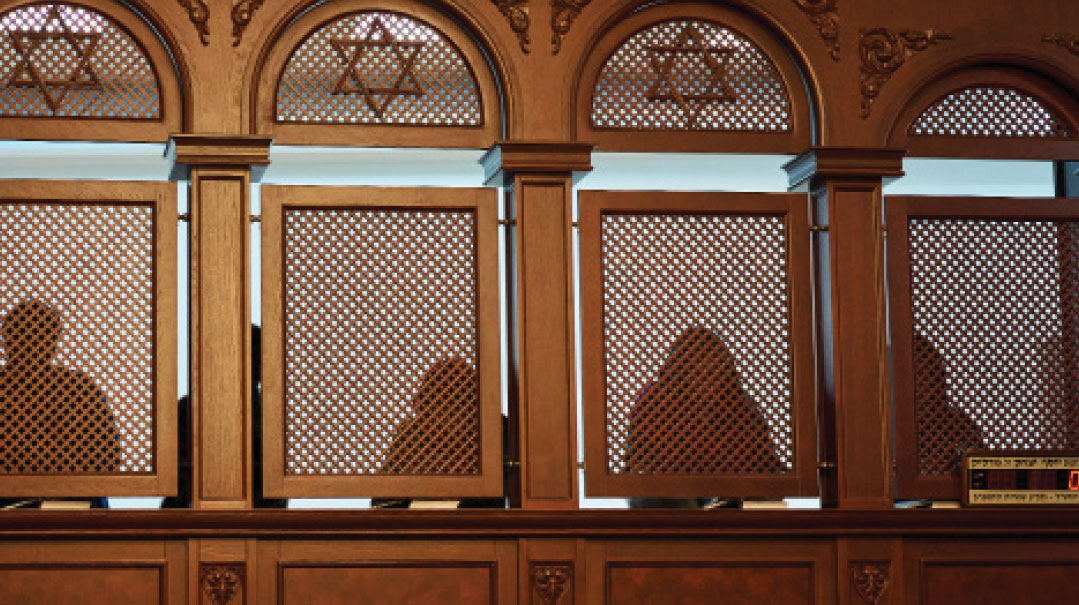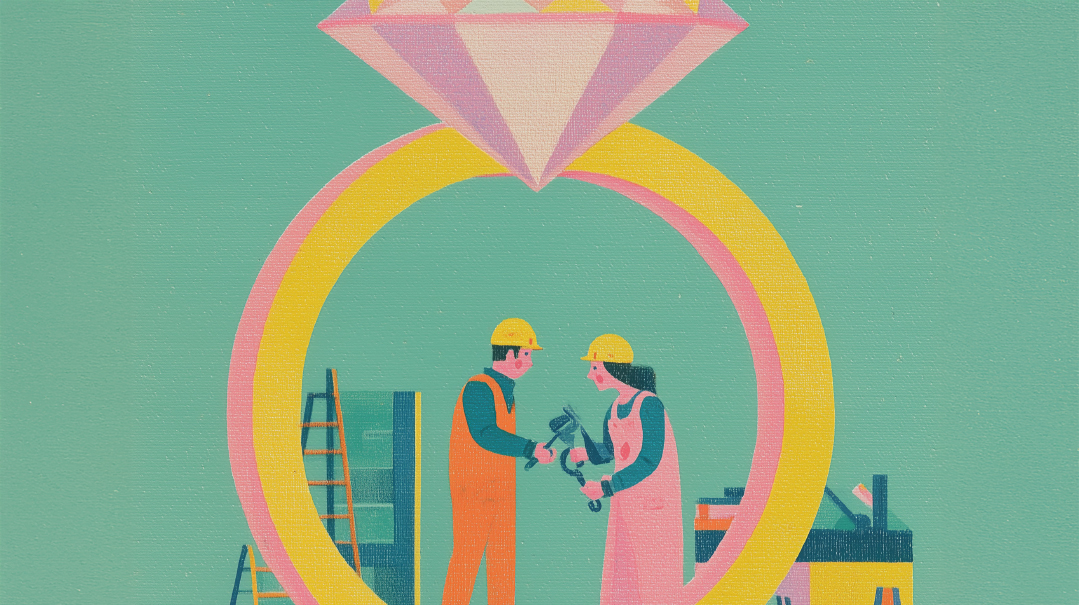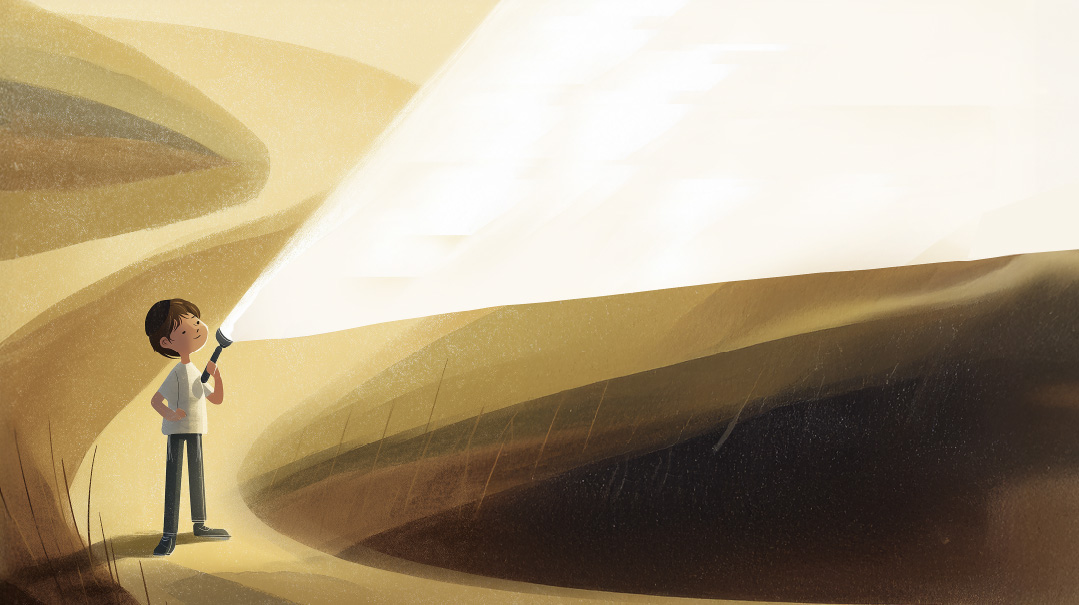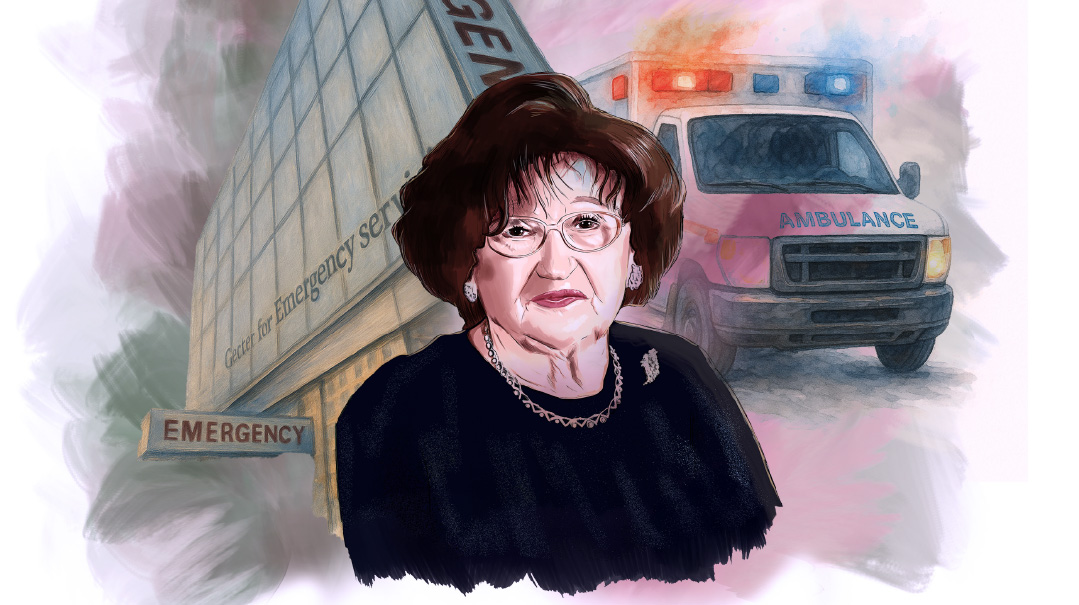In Harmony


Wives of famous chazzanim share what it’s like to be the woman behind the sheliach tzibbur

"In my eyes, chazzanus is a mission: to bring Jews closer to their Father in heaven,” says Miriam Weinbach, whose husband is Chazzan Dovid Weinbach.
In the Weinbachs’ home, as in every chazzan’s home, the awesome feeling of Elul and Tishrei arrives long before the months do. Chazzanim start practicing the haunting tunes — Hamelech, Hayom Haras Olam, Hayom Te’amtzeinu — preparing to lead their kehillos in teshuvah and tefillah. Their wives and children can sense the passion.
The wife of a chazzan is an active partner in his tefillos, says Shoshi Heller, wife of Chazzan Dov Heller. “Being a chazzan isn’t easy. It’s music without a keyboard, just the live voice with no external support. Even on your bad days or under uncomfortable conditions, you have to give your whole self and overcome the challenges.
“I’m very tuned in to the exercises and practice my husband does — and then I get to reap the fruit of all that preparation in real time in shul. I understand the small nuances. I know when it’s hard for him, when he’s struggling… at certain sections I know that in another moment he’ll be screaming, and I find myself taking a deep breath to fill my lungs with air, as if for both of us,” says Shoshi Heller. Paramount is the sense of mission these women feel, and their pride that their husbands are arousing Jewish hearts with their tefillos.
“I see people leaving Selichos feeling aroused to do teshuvah. I’m proud to have a part in that zechus,” says Miriam. “For the most part, my husband davens in front of kehillos where it’s not taken for granted that the people will come to shul on Yamim Noraim. When people hear that an excellent chazzan will be davening, they decide it’s worth it for them to leave their houses to daven. We have a real part in the tefillos of each person who participates in the tefillos on these holy days.
“My husband is a warm chassidish chazzan who sings with all his heart. His tefillos come from his soul, not from a desire to impress people. He has the ability to adapt himself to his audience,” she adds. “He can tell when the chazzanus is getting too heavy and the people are getting tired, when to add something, how to artfully weave in a new tune.”
“There are about a thousand people who daven in the shul where my husband davens,” says Shoshi Heller, “and most of them only come to shul on Rosh Hashanah and Yom Kippur. I see it as a tremendous zechus to send my husband to be a chazzan of those who are distant, to be the conduit for their tefillos to rise to the Kisei Hakavod.”
During the three weeks she spends alone with her children while her husband is abroad for the Yamim Noraim, Shoshi derives strength from the knowledge that with one moving tune, a chazzan can bring a young man considering intermarriage to make a different decision.
“You can never underestimate the impact of a powerful, passionate tefillah on the heart of a Jew,” she says.
Shoshana Adler, wife of Chazzan Chaim Adler, remembers davening in the Great Synagogue on Shabbos Rosh Chodesh Elul one year. The irreligious woman sitting next to her, not knowing she was the chazzan’s wife, told her, “Since I started coming to pray here, something has stirred in my heart. What a tefillah! I feel like I want to become religious.”
Being the wife of the chazzan also comes along with responsibility, Shoshana adds. The chazzan, like the rav, has a central role in the kehillah. “I know that I have to represent my husband properly,” she says. “I need to look and act dignified, to know how to accept the compliments and to answer nosy questions diplomatically.”
Elite Encounters
The families of chazzanim enjoy various perks. High on the list is the opportunity to come in close contact with gedolim.
Avigail Havusha, wife of renowned chazzan and paytan Reb Moshe Havusha, describes a Shabbos her family spent with Rav Ovadiah Yosef ztz”l.
“We were sitting with Rav Ovadiah Yosef’s family,” Avigail relates, “when suddenly the tzaddik came to me and said, ‘Mrs. Havusha, I’m really angry with you.’ I was scared, what had I done?
“The rav continued immediately with a small smile. ‘Why don’t you send your husband to us a little, to Hakablan Street? We also want to experience him a little.’
“Since that Shabbos, my husband began davening in the Rav’s minyan about once a month — I didn’t want to ‘anger’ the tzaddik! They loved him there, respected him, and appreciated him. On Yom Kippur, when Rav Ovadyah was alive, my husband and sons would go to the Rav’s house and sleep there, and my husband would daven the special Yom Kippur tefillos in Maran’s house. What a zechus!”
Since that time, Avigail says, her husband barely left the country. “He keeps getting calls from abroad. But he wants the zechus of davening in Eretz Yisrael. Money doesn’t speak to him.”
Miriam tells of a special zechus. “We went to a family simchah in Kiryat Sanz. Though usually only the regularly scheduled baalei tefillah daven in the Rebbe’s shul, the Rebbe realized that my husband is a yerei Shamayim and asked him to be sheliach tzibbur. After davening, he told him that he’d enjoyed it very much.”
For ten years, Shoshi Heller’s husband served as chazzan in the kehillah of Rav Yitzchok Dovid Grossman, rav of Migdal Ha’emek and founder and dean of Migdal Ohr institutions. “Davening in Rav Grossman’s shul was a real privilege,” Shoshi reminisces. “Yom Tov in Migdal Ha’emek was a very special experience. The place is beautiful, with a country-like atmosphere and lots of open grassy spaces, and the kids looked forward to going there.
“My husband would get up before dawn to learn with the Rav and get ready for davening. They’d study the meaning of the words and the significance of the tefillah, and prepare themselves for davening. After such preparation with the Rav, you come to davening in a different place. Davening is a different, more uplifting experience. The Rav sways with devotion, aflame, dressed in white. He always seems like a malach to me.”
Shoshi Heller also recalls how her family had the zechus of spending Seder night for several years with Chief Rabbi David Lau and his father, Rav Yisrael Meir Lau. “It was a special experience each time, and it left a strong impression on us and our children.”
Being a chazzan’s wife can also come along with some exciting travel benefits. “I go with my husband on organized tours that have invited him to serve as chazzan to add inspiration to the group. We’ve enjoyed trips to various countries, usually in Europe,” Miriam relates.
Families Apart
While a chazzan’s job offers his family opportunities they wouldn’t have otherwise, there’s a harder aspect of the job as well. Most famous chazzanim spend long periods of time abroad; it’s an inseparable part of the job. Many will take positions for the Yamim Noraim far from home, and when it isn’t practical for the chazzan’s family to join, his wife and children will spend several weeks alone.
When the Heller children were small, the family lived in Montreal for three years while Chazzan Heller worked in a shul there, until they moved back to Israel.
“Last year, my husband went back to serving as chazzan in Canada,” says Shoshi. “The kehillah missed him a lot. Over the past ten years, they tried several chazzanim, and in the end, they went back to him. He consulted with Rav Grossman, who told him to go.”
But with a large family, ranging from little kids to teenagers, the whole family can’t just pick up and go. “I stay alone for three weeks — and it isn’t easy — but I know that it’s the right choice.
“On Shabbos, I make Kiddush myself, but my sons sing with me. And the knowledge that my husband is doing true avodas hakodesh, a mission that not many can do, gives me strength. Most of the kehillah doesn’t understand the words of the davening, and some of them don’t know Hebrew at all. Our son Yehonason joins his father for davening, and when the kehillah hears the two of them singing together, the pintele Yid is ignited.”
Still, it’s tough. “When I go to shul, the lack is palpable. When the chazzan says ‘Tiheir Rabi Yishmael,’ which I find to be one of the most moving parts of davening, I feel a real pang,” Shoshi admits.
Avigail recalls the year her husband was away before Pesach. The Halabi community in America invited him to a Tawahid Seder — a special event celebrated on Erev Rosh Chodesh Nissan that includes songs, piyutim, and tefillos. “My husband went and I stayed here, getting ready for Pesach on my own.”
Now that Shoshana Adler’s children are grown and she has retired, she can join her husband on his trips, but she also has memories of spending Yamim Tovim alone.
“When my children were small, I stayed home with the children. I’d go to my parents, my children would go to shul, and when they got older, they went to Yerushalayim for Yom Tov, to the Gerrer Rebbe. They accepted their father’s trips as a fact of life, but they missed him a lot. They missed having a father on Yom Tov.
“We used to go to Petach Tikvah for Shabbos twice a month, bringing along all the food from home,” remembers Miriam. “As the family grew, it became more complicated, but we still preferred having the whole family spend Shabbos together. I’d cook all the food at home, pack everything up, and transport it to the ‘chazzan’s apartment’ we stayed in.”
Later, invitations started coming from abroad. “In the early years, we’d all go for Yom Tov,” she recalls. “At a certain point, we felt it was too much for us, and that the children needed our familiar chassidishe shul. Since then, I stay here for Yom Tov, even now that the children are married. It’s very important to me that my married children feel they have a warm, open home to come to.
“I listen to my husband’s stories and I’m excited along with him from afar. I handle the distance between us happily and calmly, because I know I’m doing the right thing.”
A House of Song
Many chazzanim have homes that echo with the sound of music. “All my sons sing,” Shoshi says. “From a very young age — two or three — they start singing with trills, hitting very high notes. Being born into the world of chazzanus gives them a rich and varied repertoire. At the bar mitzvah of our oldest son, Yehonason, all our boys sang for our guests.
“Children of chazzanim are born into a different reality,” she adds. “From a young age, they sit on the bimah or hide under his tallis. Everyone spoils them, and they often travel.”
Shoshana says that her sons are all very musical — they sing and play instruments. Her oldest son, Srulik, is a badchan famous for his grammen, and he recently released an album.
Avigail’s home is also filled with music. “My children are connected to davening, to chazzanus, and to the neshamah within niggun,” she says. One of her sons, a rav and paytan, is following in her husband’s footsteps.
Avigail herself was born into the world of music. “My father, sheyichyeh, is the renowned chazzan and paytan David Tzvi. Anyone who knows Yerushalayim of old must have heard of him. He was a great chazzan who sang and taught chazzanut all over the world.
“I was his personal escort. On Shabbat mornings I’d get up very early — at 3 a.m. — wake my father, and go with him for the special Shirat Habakashot in the Musayof shul.
“With my family history, I always dreamed of a husband who would be a singer and a paytan,” she shares. “Even though I missed my father when he traveled abroad, perhaps because I knew how to accept the absences as self-understood, I wanted that kind of husband.
“My husband lived in the neighborhood next to ours and would come to hear my father sing Shirat Habakashot on Shabbos. Our families knew one another, and our shidduch was natural — two songbirds!”
Breathing New Life
Music can touch people in a deep place. “Two years ago, we joined a group of children with cystic fibrosis traveling to Switzerland,” Miriam shares. “The children sat with my husband, singing, getting excited, crying.
“One of the boys, who had such a hard time breathing, asked my husband to sing ‘Lo Amus Ki Echyeh.’ We all got the chills. You could clearly see his breathing improve. It was as though the song gave him the energy to breathe.
“Another moving incident was when we were invited to a hotel in the Carpathian Mountains in Romania, near the place where three Israeli pilots were killed several years ago in a bad helicopter crash. There was a monument there in their memory.
“The entire group stood there in the Carpathian Mountains, and my husband sang “Keil Malei Rachamim” in memory of the pilots. There wasn’t a dry eye.”
Wives of chazzanim may enjoy fame and prestige; they also endure weeks alone while their husband is abroad. Above all, they feel a passionate sense of mission to enable their husbands to bring others closer to Hashem.
“Chazzanus isn’t about impressive vocal acrobatics,” says Miriam. “A real chazzan is someone who can transmit kavanah, putting his soul in his singing and davening. Good chazzanus opens the heart so a person can daven from a deeper place.”
Fathers and Sons
Sarah Moses Spero
I’m not too good at finding my way around all the holy books, but drop a Rosh Hashanah or Yom Kippur machzor in my lap, and I’m home.
I’m spoiled. My father, a graduate of Auschwitz, was a rabbi whose responsibilities included leading the High Holiday Services. I can still remember some of the tunes he used, and I was 13 the last time I heard him daven.
For the years that I was an out-of-town student in Yavne in Cleveland, Telshe Yeshivah was my address for the Yamim Noraim. Need I say more? Being part of a 500-voice choir lifted in supplicating song is something that never leaves you.
My husband, Abby, was the baal Shacharis at our Young Israel of Cleveland/Hebrew Academy branch for more years than the Jews wandered the desert. The nusach and customs that came from Bartfeldt, Hungary, was what these founding members brought with them a few generations ago. They are still being used today when our oldest son, Chaim, serves as a baal Shacharis in Baltimore.
It’s a family thing. As Leviim, they come by it honestly. Hubby’s grandfather was a baal tefillah, his father, was the baal Mussaf, and his brother, Shmulie, took over for his own father.
My mother-in-law had three sons. There were many years that she was so filled with nachas on Rosh Hashanah, she did not have to eat. One son was the baal Shacharis, one blew shofar, and one was the baal Mussaf — all in the same shul. Does it get better than that?
When I joined the family and sat in the English Lavender row — my mother-in-law’s favorite fragrance — Shmulie, had already been the baal tefillah for quite a while, and it wasn’t just my mother-in-law who held her breath as he began Hineni. There are generations of men and women who learned the importance of these whispered words through the almost silent, choke-filled voice with which he would begin.
In silence, we would all wait.
Shmulie, wearing his father’s tallis, would approach the amud with reverence and a single-minded resolve that was not only seen but felt.
We all knew that on the first day of Rosh Hashanah, Hineni and Unesaneh Tokef would be said through quiet sobs. The second day would sometimes be better. Ne’ilah on Yom Kippur was a watershed moment.
Shmulie didn’t just daven. Shmulie talked to G-d and let you listen. I am not the only one who felt that way. It is an everlasting tribute to a man whose soul defined him. So beloved was his davening and so sincere his ability to convey the meaning of the words that there are baalei tefillah today who, nurtured in that environment, continue to use his nusach.
Our youngest son, Yehuda, is one of them.
Shmulie was the baal Mussaf for 50 years and continued to lead and inspire even after he had been diagnosed with the illness that eventually stilled his prayerful spirit. He had fought the good fight and was very ill the year that Yehuda came back to be the baal tefillah in our shul.
On Erev Yom Tov they all went to visit him in the hospital. Shmulie was already very weak, and when they entered his room, he opened his eyes and asked Yehuda to sing for him.
And there, on the fifth floor of University Hospital, in a too-crowded room with his family around him, Yehuda sang for Shmulie his beloved “Unesaneh Tokef.” It was an exquisite moment in time.
On the first day of Rosh Hashanah, they all walked back and forth to the hospital — over an hour each way — to see Shmulie again.
When they entered his room, Shmulie perked up and asked how the davening went. “What did you use for this, and how did you end that?”
Five weeks later Yehuda returned to Cleveland and sang the Keil Malei Rachamim at Shmulie’s funeral.
Today, the silence of waiting for the Hineni to begin reminds me of how different things have become and yet how much they are all the same.
I am comforted by the familiarity of knowing that the responsibility of those words is now being carried by the next generation. Yehuda is named after my father, whose yahrtzeit is on the second day of Rosh Hashanah.
Some of Yehuda’s niggunim and nusach are part of generations that have come before him. When Yehuda begins Hineni he does not stand alone. Under his tallis and woven within the folds of those evocative notes are memories of people and places whose spirits, I sense, return to help carry his — and our — tefillos to where they belong… accompanied by just a hint of English Lavender.
(Originally featured in Family First, Issue 710)
Oops! We could not locate your form.







